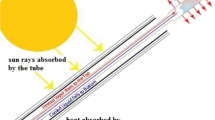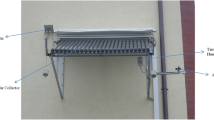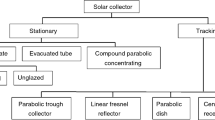Abstract
The purpose of this study was to experimentally investigate the thermal performance and operating characteristics of various heat pipe working fluids in evacuated tube solar collectors. Heat pipe efficiency was evaluated by calculating the solar collector efficiency value when using four types of working fluids: water, ethanol, flutec-pp9 and methyl acetate under the same operating conditions on an indoor experiment apparatus. The experimental conditions were as follows: The inclination angle of the evacuated tube solar collectors were 20°, 40° and 60° from the normal basis. The mass flow rate into the manifold of the evacuated tubular solar collector was 0.3 kg/min. The heat flux on the collector surface was 870 W/m2. The results showed that, at an angle of incidence of 40°, the values of \({\text{F}}_{\text{R}} \left( {\tau \alpha } \right)\) and \({\text{F}}_{\text{R}} {\text{U}}_{\text{L}}\) with methyl acetate as the working fluid were 0.6572 and −2.0086, respectively, with water they were 0.6636 and −1.8457, respectively, ethanol they were 0.6147 and −0.6353, respectively, and with flutec-pp9 they were 0.525, and −3.2313, respectively.









Similar content being viewed by others
Abbreviations
- A c :
-
Collector area (m2)
- C p :
-
Specific heat (J/kg °C)
- \(\dot{m}\) :
-
Mass flow rate (kg/s)
- Q u :
-
Useful energy gain (W)
- \(\tau \alpha\) :
-
Transmittance–absorptance product
- F R :
-
Heat removal factor
- U L :
-
Overall heat transfer coefficient (W/m2 °C)
- G T :
-
Irradiation on a collector surface (W/m2)
- \(\eta\) :
-
Solar collector efficiency (−)
- T :
-
Temperature (°C)
- T ap :
-
Absorber plate temperature (°C)
- T a :
-
Ambient temperature (°C)
- T i :
-
Inlet temperature (°C)
- T o :
-
Outlet temperature (°C)
- M :
-
Merit number (kW/m2)
- \(\rho_{l}\) :
-
Density of the liquid (kg/m3)
- \(\sigma_{l}\) :
-
Surface tension (N/m × 102)
- \(\mu_{l}\) :
-
Viscosity of the liquid (cP)
- \(L\) :
-
Enthalpy of vaporization (kJ/kg)
References
Zhao J, Rao Z, Liu C, Li Y (2016) Experimental investigation on thermal performance of phase change material coupled with closed-loop oscillating heat pipe (PCM/CLOHP) used in thermal management. Appl Therm Eng 93:90–100
Arab M, Abbas A (2014) A model-based approach for analysis of working fluids in heat pipes. Appl Therm Eng 73:751–763
Chun WG, Kang YH, Kwak HY, Lee YS (1999) An experimental study of the utilization of heat pipes for solar water heaters. Appl Therm Eng 19:807–817
Wu SC, Huang CJ, Chen SH, Chen YM (2013) Manufacturing and testing of the double-layer wick structure in a loop heat pipe. Int J Heat Mass Transf 56:709–714
Lu X, Wei JJ (2014) Experimental study on a novel loop heat pipe with both flat evaporator and boiling pool. Int J Heat Mass Transf 79:54–63
Kim HJ, Lee SH, Kong YC, Jang SP, Choi JH, Koo J (2015) Long-term reliability of the thermal performance of a flat-plate heat pipe using a prognostics method. Int J Heat Mass Transf 82:369–372
Dunn PD, Reay DA (1982) Heat pipes, 3rd edn. Pergamon Press, Oxford, pp 23–137
Tiwari GN (2002) Solar energy, fundamentals, design, modelling and applications. Narosa Publishing House, New Delhi, pp 150–168
Duffie JA, Beckman WA (2013) Solar engineering of thermal processes, 4th edn. Wiley, Newark, pp 236–370
Acknowledgements
This research was supported by a Grant (Code 15IFIP-B065893-03) from the Industrial Facilities & Infrastructure Research Program funded by the Ministry of Land, Infrastructure and Transport of the Korean government.
Author information
Authors and Affiliations
Corresponding author
Rights and permissions
About this article
Cite this article
Joo, HJ., Kwak, HY. Experimental analysis of thermal performance according to heat pipe working fluids for evacuated tube solar collector. Heat Mass Transfer 53, 3267–3275 (2017). https://doi.org/10.1007/s00231-017-2029-0
Received:
Accepted:
Published:
Issue Date:
DOI: https://doi.org/10.1007/s00231-017-2029-0




